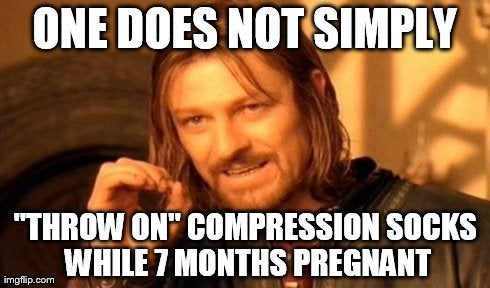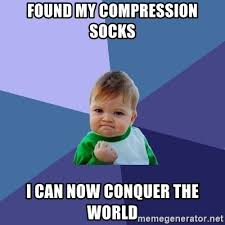
Introduction
Chances are, you have heard of compression stockings, or elastic stockings as some may call it and you are wondering which kind will best suit you. As you continue reading and scrolling, you will find a sense of relieve as this page will help you identify the right method to choose the right elastic stockings for you.
Compression stockings or elastic stockings are highly beneficial medical hosiery used to treat various venous disorders. It can be used to avoid or reduce the amplification of blood clots and inflamed veins. Some types of venous disorders are chronic venous insufficiency, deep vein thrombosis, post thrombotic syndrome, pulmonary embolism to name a few.

What is DVT?

You started to notice some spider veins on your legs, and you’re wondering why you have them all of a sudden. This may seem a little scary and the first thing you do, is to search for answers online to try to digest everything that is going on, identify the causes and what to do next. High chances of this three word medical condition popping up: Deep vein thrombosis, DVT for short.
Based on the American Journal of Preventive Medicine, in United States alone, almost 600,000 people may have been troubled by venous thromboembolism (both pulmonary embolism and deep vein thrombosis) annually. Thus, it is a major issue which needs to be addressed.
Before we move further, let’s get a deeper understanding of deep vein thrombosis. No pun intended. There are many causes as to why people develop venous disorders. One of the main causes, as mentioned above, is the lack of blood circulation. Venography, magnetic resonance imaging and duplex ultrasound are all methods used to detect venous diseases. So, when does DVT occur and how much of exposure really affects the body?
Why does this happen?
Let’s take a closer look at the biological movement to further understand this issue. From the heart, the oxygenated blood flows and travels to the entire body to supply the necessary nutrients required by all organs and cells.
When there is a lack of circulation, the blood or rather what it carries (red and white blood cells, plasma and platelets) are not able to flow and appear to be trapped at the vein valves.
When the valves are damaged and aren’t fully functional, it may turn into what is known as chronic venous insufficiency. This then may cause the blood cells to clot, creating a clump or deep vein thrombosis. Hence the formation of vivid venous, bruise-like appearance on your legs (or any other part of your body for that matter).
If the clump is dislodged, it can travel to the lungs, causing a life-threatening complication called a pulmonary embolism.
How can I prevent it?
If you are usually someone who stands or sits all day at work, then you may have higher chances of developing spider veins or DVT. Or perhaps, you are a frequent flyer on long-haul flights? You may be overweight, or recovering from a major surgery, or even heavily pregnant.
All these may seem to vary; however, there is one common factor which holds true and plays a crucial role in identifying the culprit of DVT: Circulation.

Circulation and Elastic Stockings
How do you keep your body moving and constantly provide better blood flow and circulation when all of the above isn’t something you can change overnight? Perhaps you are recovering from a major surgery and are unable to perform rigorous forms of exercise or are unable or get out of bed frequently.
How do you prevent the issue from spreading or worsening without having to quit your job as a nurse, or if you’re halfway through your pregnancy? Or maybe both?
One of the best things you could do is to speak to your physician immediately and get your hands on some elastic stockings. It is also recommended to ensure that you are moving your body to let your blood flow freely.
What do you use it for?
Compression stockings are designed to be elastic, where the built up pressure helps blood to flow freely and circulate smoothly. Think of it as a long, warm leg-hug that keeps the blood flowing all the way from your legs to your ticker.
Besides this, compression stockings are also used to reduce swellings known as Edema.
There are various kinds of elastic stockings readily available for purchase out there. Let’s go through the various factors we need to consider prior to purchasing a pair.
How can you choose the right compression stockings?
Although you will have to use it for a few hours, on a daily basis, compression stockings aren’t exactly the most comfortable pair of hosiery. As such, it is very important to choose the right type of stockings which gets the job done and doesn’t feel like you’re about to lose your limbs. This will allow you to move around comfortably without hindering your day to day activities.
Therefore, choose close-fitted yet comfortable stockings for hassle-free mobility. Several essential factors may affect your purchasing decision such as the material of the compression stockings, shape and size, compression level as well as its aesthetics and appearance.
Who should use it?
Another important point to consider is the fact that you may have to use the stockings for long periods of time. There are certain users who opt to use elastic stockings as a preventive measure because they fall under the risky category. However, users opt to wear them under different circumstances. Therefore, it is best to consider the options after speaking to a physician.
Using it on a daily basis
If you suffer from venous disorders, perhaps you may have to use it on a daily basis, on hours end. The span of which you will have to use it long term may be different as well. It can be from several months to years.
A study by UK National Institute for Health and Care Excellence (NICE) had shown that the usage of compression stockings for two years have reduced the post thrombotic syndrome by half.
A lot of users whose professions require them to stand all day long usually use the elastic stockings on a daily basis. For instance, nurses, cashiers, doctors, teachers, hairdressers etc. Basically, anyone whose job requires them to be on their feet.
As and when needed
If you are a frequent flyer, you may not have to use it on a daily basis. However, it is recommended that you use the compression stockings all through the flight and only remove them once you have landed. In fact, there was a study by Weiss & Duffy (1999) which showed that flight attendants who used compression stockings during their flights had reduced their chances of swelling and fatigue significantly.
Another group of users may be athletes, to reduce recovery time and boost athletic accomplishments. It also has been found that it reduces muscle soreness and improves venous blood flow. Pregnant women may also have to use elastic stockings, given that it will ease swelling and edema. Apart from this, it may also relieve the pain and numbness associated with the swelling.

Material
Given that the compression stockings are meant to be elastic and stretchy, choose stockings made of proper materials such as Spandex or Elastane as some may call it. It is one of the fabric components used to create the elasticity needed. This material is soft and helps the stockings stay in shape. This adds to comfort and durability of the stockings, given that you will most likely use it on a daily basis for a long period of time.
Speaking of durability, Nylon appears to be one of the most long-lasting fabrics which are able to endure countless washings and abrasion. Combined with an elastic material, it provides both comfort and durability for maximum wear and tear.
Provided that compression stockings are usually used for hours, comfort plays a very important role. Imagine being a nurse who barely sits in a day to be stuck with compression stockings which are uncomfortable and too tight. As such, the divine combination of nylon and elastane is chemical heaven.
Length and Size
Knee high versus Thigh high

When it comes to elastic stockings, there are two main types that people generally look for; The Knee high and the thigh high elastic stockings. Both are recommended, suitable for preventative measures and have their pros and cons. It all boils downs to the needs and requirements of the user.
Based on multiples studies by Sajid et al, knee high elastic stockings were compared to thigh high elastic stockings. Although almost 500 patients took part in these studies, no significant results were obtained to identify whether the former or the latter is more effective.
However, in terms of comfort, it was noted that the knee length stockings were much easier to put on. Knee High stockings usually are more comfortable for those who prefer compression on their legs, with more mobility.
Sizing
Apart from the length, the regular sizing should also be considered based on your body size. Keeping in mind that a snug fit is necessary, it is always crucial to compare the size of the socks to your legs. Always refer to the available size chart and further explanation befittingly.
Level of Compression

A familiar unit of measurement is the mmHg which stands for millimeters of Mercury. The levels of measurement indicate the different levels of pressure or compression it will provide for better circulation. In other words, the higher the mmGh, the higher the support.
It is an important measurement to understand the amount of compression needed for the blood to circulate and flow successfully. There are several different categories for the pressure as per the table below. It is important to use the elastic stockings which are compatible to the level of compression needed, as it varies between patients and severity of the disorders faced.
The range of compression levels are 10–15 mmHg, 20-30 mmHg, 30-40 mmHg and 40-50 mmHg. 10–15 mmHg provides superlight aid while 20-30 mmHg provides moderate support. 30-40 mmHg and 40-50 mmHg usually provides much more firm support. The lower levels of compression can be purchased over the counter whereas higher pressure levels usually require a doctor’s prescription.
Fashion

The first thing anyone thinks of when it comes to compression stockings is a pair of dull nude stockings that may not necessarily remind you of high-fashion. It can be slightly difficult to think of these socks as being a pair of really attractive stockings. It is also challenging to pair them with other clothing to seem fashionable.
Thankfully, there have been a lot of improvement in terms of design and many people can wear these stockings and fit them to the daily lifestyle. Nowadays, there are many available colors and designs which might suit the user’s needs and wants.
Conclusion

In a nutshell, elastic stockings are extremely beneficial, providing major preventive care and life-saving support for users of all walks of life. As such, it certainly increases the quality of life for many people. There are currently many different types of elastic stockings out there. Given the different options to choose from, the most crucial part is to remember choosing the type that caters to you and your distinctive needs. Whether you are a male or female, a young adult or a senior citizen, whether you’re an athlete or expecting a baby, there are a plethora of elastic stockings to choose from. So, choose wisely and begin the hunt!
